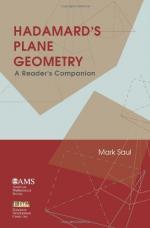|
This section contains 671 words (approx. 3 pages at 300 words per page) |

|
Euclidean geometry, sometimes called parabolic geometry, is a geometry that follows a set of propositions that are based on Euclid's five postulates (see Euclid's axioms), as defined in his book The Elements. More specifically, Euclidean geometry is different from other types of geometry in that the fifth postulate, sometimes called the parallel postulate, holds to be true. Non-Euclidean geometry replaces this fifth postulate with one of two alternative postulates and leads to hyperbolic geometry or elliptic geometry. There are two types of Euclidean geometry: plane geometry, which is two-dimensional Euclidean geometry, and solid geometry, which is three-dimensional Euclidean geometry.
Euclid's five postulates can be stated as follows:
1. It is possible to draw a straight line segment joining any two points.
2. It is possible to indefinitely extend any straight line segment continuously in a straight line.
3. Given any straight line segment, it is possible to draw a...
|
This section contains 671 words (approx. 3 pages at 300 words per page) |

|


